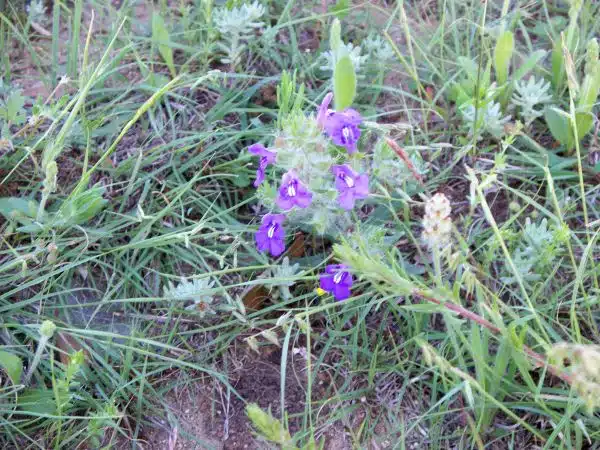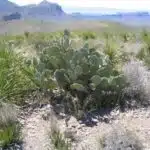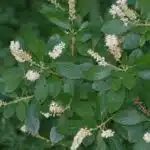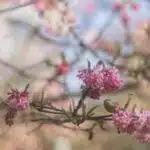Texas sage, also known as Leucophyllum frutescens, is a popular ornamental shrub native to the southwestern United States and Mexico. It is highly valued for its drought tolerance, low maintenance requirements, and stunning blooms that appear in late summer and fall. If you’re looking to add a touch of desert beauty to your garden or landscape, Texas sage is an excellent choice.
In this article, we will explore everything you need to know about growing and caring for Texas sage. From choosing the right location to watering and fertilizing techniques, we will cover all aspects of cultivating this hardy plant. Whether you’re a seasoned gardener or a beginner looking to try something new, this guide will provide you with valuable insights into how to successfully grow and care for Texas sage. So let’s dive in!
Overview Of Texas Sage
Texas sage, also known as Texas ranger or barometer bush, is a popular shrub among gardeners and landscapers. It is native to the southern regions of the United States and Mexico and can grow up to 8 feet tall and wide. The plant features silver-gray leaves that are densely packed, creating an attractive foliage that contrasts well with its stunning blooms.
One of the benefits of Texas sage is its drought-tolerant nature. It thrives in hot and dry conditions, making it an excellent choice for xeriscaping projects. Additionally, it attracts pollinators such as bees and butterflies, which makes it an ideal addition to any wildlife-friendly garden. Moreover, Texas sage’s striking purple or white flowers add a touch of elegance to any landscape design.
Texas sage is easy to care for and maintain, making it a popular choice among novice gardeners. The plant prefers full sun exposure but can tolerate partial shade in hotter climates. It requires well-draining soil and only needs occasional watering once established. There are several varieties available in the market today, each with unique characteristics such as flower color, leaf shape, and size. With proper cultivation techniques, Texas sage can bloom from spring through fall, providing year-long aesthetic appeal to any garden or landscape design.
As an adaptable plant that adds both beauty and functionality to any outdoor space, Texas sage is an excellent investment for homeowners who want to enhance their property’s curb appeal while also enjoying the benefits of a low-maintenance shrub. To successfully cultivate this plant in your area, it’s essential first to understand its growing zones and climate requirements.
Climate And Growing Zones
As we previously discussed, Texas Sage is a popular plant known for its lovely silver foliage and purple blooms. However, despite its beauty, there are some growing challenges that gardeners may encounter when trying to grow this shrub. One of the primary concerns is the climate and growing zones where Texas Sage can thrive.
Texas Sage grows best in areas with hot and dry climates, such as the Southwestern United States. The plant prefers full sun exposure for at least six hours a day and requires well-draining soil. If you live in an area with high humidity or frequent rainfall, you may need to make seasonal adjustments to ensure your Texas Sage thrives.
Another challenge to growing Texas Sage is finding the right soil requirements. This plant is tolerant of many soil types but prefers alkaline soils with a pH between 7.0-8.5. To avoid root rot, it’s essential to ensure adequate drainage in the planting area. You may also need to amend your soil with organic matter or sand if you have dense clay or compacted soils.
In conclusion, growing Texas Sage can be challenging depending on your climate and soil conditions. However, with proper care and attention, this beautiful shrub can thrive in many different environments. In the next section, we will discuss the specific soil requirements needed for healthy growth of Texas Sage plants.
Soil Requirements
Texas sage is a relatively low-maintenance plant that is popular for its beautiful purple flowers and aromatic foliage. However, proper soil preparation is crucial for optimal growth and overall health of the plant. The ideal soil type for Texas sage is well-draining, sandy loam with a pH level between 7.0-8.5.
Soil preparation should be done before planting Texas sage. Start by removing any weeds or grass from the planting area, then loosen the soil to a depth of at least 8 inches. Mix in organic matter such as compost or peat moss to improve soil structure and nutrient availability for the roots. Additionally, if you have heavy clay soil or poor drainage, it’s recommended to add sand or gravel to increase drainage and prevent waterlogging.
Drainage improvement is crucial when growing Texas sage since it’s susceptible to root rot in poorly drained soils. To improve drainage, create raised beds or planting mounds using well-draining soils and avoid overwatering. Mulching around the base of the plant can also help retain moisture and prevent weed growth while improving soil fertility. By preparing the right soil conditions, you’ll set your Texas sage up for healthy growth with minimal care needed.
Moving into sunlight needs for Texas sage, it’s important to note that this plant requires full sun exposure for optimal growth and flowering.
Sunlight Needs
- Texas sage (Leucophyllum frutescens) is an evergreen shrub that is native to the southwest United States, and thrives in full sun exposure.
- It should be planted in an area that receives at least six hours of direct sunlight each day for optimal growth.
- The plant is tolerant of some shade, but it is important to avoid prolonged periods of deep shade that can stunt the growth of the shrub.
- When planted in an area that receives too much shade, the plant may become leggy and sparse.
Sunlight Exposure
Texas sage is a popular ornamental plant that is native to the southwestern region of the United States. One of the key factors in growing and caring for Texas sage is providing it with proper sunlight exposure. In general, Texas sage thrives in bright, direct sunlight and requires at least six hours of full sun each day.
For indoor cultivation, it is important to place Texas sage near a window or in a location that receives plenty of natural light. However, it is important to note that Texas sage also has some tolerance for shade. If you are not able to provide your Texas sage with enough direct sunlight, it can still thrive with partial shade or filtered light.
It is important to monitor your Texas sage’s sunlight exposure carefully. Too much direct sunlight can cause leaf burn or other damage, while too little sunlight can cause the plant to become weak and leggy. With proper care and attention to its sun needs, your Texas sage plant will thrive and add beauty to any landscape or indoor space.
Shade Requirements
Texas sage is a versatile plant that can grow both indoors and outdoors. As discussed in the previous subtopic, sunlight exposure is crucial for its growth and development. However, it is also essential to understand the plant’s shade requirements. Texas sage is shade tolerant and can grow well in partial shade or filtered light if it does not receive enough direct sunlight.
The optimal shade levels for Texas sage growth depend on various factors such as geographical location, temperature, humidity, and soil conditions. In general, the plant needs at least six hours of direct sunlight each day to thrive. However, if you live in an area with intense heat or high temperatures during the summer months, providing some shade during midday can help prevent leaf burn or other damage.
If you are growing Texas sage indoors, placing it near a window that receives plenty of natural light is ideal. But if your space lacks adequate sunlight exposure, you can still grow a healthy plant by providing partial shade or filtered light. It’s essential to monitor your Texas sage’s response to different levels of sun and shade carefully. With proper care and attention to its sun and shade requirements, your Texas sage plant will thrive and add beauty to any landscape or indoor space.
Watering Techniques
Texas sage is a drought-tolerant plant, which means it can survive with minimal watering. However, proper watering techniques are still necessary to ensure the health and vitality of your plant. When you first plant your Texas sage, make sure to give it enough water to establish its root system. After that, you should only need to water it once every two weeks during the growing season. During the dormant season, watering can be reduced even further.
One of the most important aspects of watering Texas sage is proper drainage. Texas sage requires well-draining soil to prevent root rot and other diseases caused by standing water. If your soil doesn’t drain well, you may need to amend it with sand or compost to improve drainage. Additionally, if you’re planting in a container, make sure there are holes in the bottom for excess water to drain out.
If you live in an area with particularly hot or dry weather, there are some drought-tolerant options that can help reduce the amount of water needed for your Texas sage. For example, mulching around the base of your plant can help retain moisture in the soil and reduce evaporation. You can also consider using drip irrigation or a soaker hose instead of overhead watering methods to minimize water loss through evaporation. By following these proper watering techniques and utilizing drought-tolerant options when possible, you can help ensure the success and longevity of your Texas sage plants.
As mentioned earlier, proper watering techniques are crucial for Texas sage plants’ health and longevity; however, fertilizing best practices should also be considered for optimal growth results.
Fertilizing Best Practices
Fertilizing is an essential aspect of caring for Texas sage plants. The type of fertilizer you use can greatly impact the health and growth of your plant. Organic fertilizers are an excellent choice for those looking to be environmentally conscious and avoid harmful chemicals. They release nutrients slowly over time, providing a steady stream of nourishment to the plant.
Chemical fertilizers, on the other hand, are designed to quickly release nutrients into the soil. They can provide fast results but may have negative impacts on soil health in the long run. Regardless of which type of fertilizer you choose, it’s important to apply it at the right time. For Texas sage plants, it’s best to fertilize in early spring and again in late summer or early fall.
When applying fertilizer, make sure to follow the instructions on the package carefully. Over-fertilizing can lead to stunted growth or even damage to the plant. Additionally, be sure not to apply fertilizer too close to the stem, as this can burn the roots and cause harm to your Texas sage plant. With proper fertilization techniques, your Texas sage will thrive and continue to add beauty and value to your garden space.
As important as fertilizing is for Texas sage plants, pruning and trimming also play a vital role in their overall health and appearance. By removing dead or diseased branches, you promote healthy growth and prevent potential problems from arising later on. In our next section, we’ll discuss some tips for effective pruning and trimming that will help keep your Texas sage looking its best all year round.
Pruning And Trimming Tips
One example of the importance of pruning and trimming when caring for Texas sage is when the plant becomes too large for its space. If left unattended, it can become woody and unattractive, and may even block out sunlight to other plants nearby. In this case, selective pruning can help remove any dead or diseased branches and promote new growth.
When it comes to pruning techniques for Texas sage, it is important to keep in mind the natural shape of the plant. This shrub has a tendency to grow with a rounded, mounding form that can be accentuated with careful shaping. One option is to use hand pruners or shears to trim back the tips of branches in a uniform manner, which can encourage bushier growth and fuller foliage.
Another shaping option for Texas sage is to allow the plant to grow more naturally but still maintain its overall size and shape. To achieve this, use lopping shears to selectively remove larger branches at their base rather than just trimming back their tips. This technique can create an open framework that allows light and air circulation into the center of the plant.
To maintain healthy growth and appearance of your Texas sage, proper pruning and shaping are essential tasks. Whether you choose to trim back tips or selectively remove larger branches, it’s important not to overdo it as this can weaken the plant or cause flowering issues. In our next section, we will discuss some common pests and diseases that you should watch for when caring for Texas sage.
Pests And Diseases To Watch For
Aphids are a common pest on Texas sage and can be identified by their pear-shaped bodies and piercing-sucking mouthparts. Whiteflies are another pest of Texas sage, which can be identified by their white, moth-like wings and small size. Root rot is a disease of Texas sage caused by pathogens in the soil, characterized by discoloration and wilting of the leaves. Powdery mildew is a fungal disease of Texas sage identified by white, powdery patches on the leaves, stems, and flowers.
Aphids
Aphids are one of the most common pests that can invade your Texas sage. These tiny insects have soft bodies and feed on the sap of plants, causing yellowing and curling of leaves. Seeing your beloved plant being attacked by aphids can be frustrating, but don’t worry, there are natural remedies and prevention techniques to keep them at bay.
One way to prevent aphids from invading your Texas sage is to encourage beneficial insects like ladybugs and lacewings in your garden. These insects feed on aphids and help control their population naturally. Additionally, regularly inspecting your plants for signs of infestation and promptly removing affected leaves or branches can help prevent the spread of aphids.
If an infestation has already occurred, there are natural remedies that you can use to get rid of aphids. A simple solution is to mix a few drops of dish soap with water in a spray bottle and apply it directly on the affected areas. The soap will suffocate the aphids without harming your plant. Another option is to use neem oil or insecticidal soap, which are both effective against aphids but are gentle on your plant’s foliage. Remember that prevention is always better than a cure, so take good care of your Texas sage to avoid pest problems altogether.
Whiteflies
Moving on to another pest that can damage your Texas sage, let’s talk about whiteflies. These tiny insects are closely related to aphids and feed on the sap of plants, causing wilting, yellowing, and stunted growth. Whiteflies are common in warm and humid environments, which makes Texas a perfect breeding ground for them.
To prevent whiteflies from infesting your Texas sage, you can implement natural remedies and pest control methods. One effective way is to use reflective mulch around your plants as it deters whiteflies from landing on them. Another method is to introduce beneficial insects like parasitic wasps or ladybugs into your garden as they feed on whiteflies’ eggs and larvae.
If whiteflies have already invaded your Texas sage, there are natural remedies that you can use to control their population. One option is to spray neem oil or insecticidal soap directly on the affected leaves as these products disrupt the insects’ life cycle without harming beneficial insects or your plant’s foliage. You can also try using sticky traps or vacuuming up the adult flies to reduce their numbers.
In summary, while aphids are a typical pest problem for Texas sage, whiteflies should not be overlooked either. By implementing preventive measures and utilizing natural remedies such as reflective mulch or neem oil, you can protect your plant from these damaging pests. Remember to monitor your plant regularly for signs of infestation so that you can take action promptly if needed.
Propagation Methods
Propagation Methods:
Texas sage can be propagated by both seeds and cuttings. Propagation techniques for Texas sage involve collecting mature seeds in the fall, and sowing them in well-draining soil. The seeds should be planted at a depth of one-quarter to half an inch below the soil surface. It is important to keep the soil moist but not waterlogged until germination occurs, usually within two to four weeks. Once the seedlings have developed their second set of true leaves, they can be transplanted into individual containers or directly into the ground.
Another propagation method for Texas sage involves taking cuttings from a mature plant. Cuttings should be taken from new growth in the spring or summer when the plant is actively growing. Using clean pruning shears, cut a six-inch section of stem just below a leaf node. Remove all but the top two sets of leaves and dip the cut end into rooting hormone before planting it in well-draining soil. Keep the soil moist but not waterlogged until roots develop, usually within four to six weeks.
Rooting hormones are essential when propagating Texas sage using cuttings as they encourage root development and increase the chances of success. Rooting hormones are available at most garden centers and come in powder, gel, or liquid form. When using rooting hormone powder, dip the cutting’s base into water first before dipping it into the powder. For liquid or gel forms, simply follow the manufacturer’s instructions for application.
Transition:
Now that you know how to propagate your own Texas sage plants using either seeds or cuttings with rooting hormones let’s move on to container gardening with this beautiful shrub!
Container Gardening With Texas Sage
Picture this: a beautiful Texas Sage blooming on your patio, filling the air with its pleasant aroma. Container gardening with Texas Sage is an excellent way to add color and fragrance to your outdoor space. With the right container design and soil selection, you can grow healthy and vibrant plants that will thrive in a confined space.
When choosing a container for Texas Sage, consider its size and style. The container should be large enough to accommodate the plant’s root system while providing sufficient drainage holes at the bottom. The style of the container should complement your outdoor décor, adding visual interest without overpowering the plant’s beauty. A good rule of thumb is to choose a pot that is at least twice as wide as the plant’s root ball.
The soil selection is critical when it comes to growing Texas Sage in containers. Choose a well-draining soil mix with perlite or coarse sand added to prevent water from stagnating around the roots. Avoid using heavy garden soil or clay since they retain water for extended periods, leading to root rot. Once planted, water only when the top inch of soil feels dry to touch, and fertilize every four weeks during the growing season for optimal growth. With these tips in mind, you can enjoy a thriving Texas Sage in your container garden!
For those seeking creative landscaping ideas and design tips using Texas Sage, there are numerous options available. From pairing it with other drought-tolerant plants such as cacti or agave to creating a focal point by placing it in a brightly colored container, there are endless possibilities when it comes to incorporating Texas Sage into your landscape design. Additionally, pruning after flowering promotes bushier growth and enhances its natural shape, making it an ideal choice for topiary designs or clipped hedges. Let your creativity flow as you explore different ways of incorporating this stunning plant into your landscape!
Landscaping Ideas And Design Tips
Container gardening with Texas Sage can be a great way to add a touch of color and texture to any small space. However, if you have a larger area to work with, landscaping ideas and design tips can help create an impressive display. When it comes to color schemes for your Texas Sage plantings, consider pairing the silvery-grey foliage with plants that have bright hues like orange or pink. This creates an attractive contrast that will catch the eye of anyone passing by.
In addition to adding color, water feature ideas can also enhance the overall aesthetic of your Texas Sage landscape design. A simple fountain or pond can provide a soothing backdrop for these hardy shrubs while attracting birds and other wildlife. When incorporating water features into your garden design, it’s important to consider the size and location in relation to your Texas Sage plants. You don’t want water runoff damaging their roots or causing them to become waterlogged.
Overall, when planning your Texas Sage landscape design, be sure to choose common varieties of texas sage that are well-suited for your climate and soil conditions. Some popular varieties include Leucophyllum frutescens ‘Green Cloud’, which has dark green leaves and purple flowers; ‘Compacta’, which is known for its tightly packed foliage; and ‘Thundercloud’, which produces vibrant pink flowers in summer. By selecting appropriate varieties and incorporating complementary colors and textures into your design, you can create a beautiful outdoor space that both you and others will enjoy.
Common Varieties Of Texas Sage
Texas sage, also known as Leucophyllum frutescens, is a popular ornamental plant that is native to the southwestern regions of the United States. It is an evergreen shrub that blooms with beautiful purple, pink, or white flowers during the summer months. One interesting fact about Texas sage is that it has a unique aroma that intensifies after rainfall, hence its nickname “barometer bush.” Commonly used in xeriscaping and drought-tolerant landscaping, this plant requires minimal care and can tolerate extreme temperatures and soil conditions.
There are several varieties of Texas sage available in the market, each with distinct physical characteristics and blooming patterns. Varieties comparison reveals that ‘Compacta’ is a dwarf variety that only grows up to 3 feet tall and wide, making it an excellent choice for small gardens or containers. ‘Green Cloud’ produces large clusters of lavender flowers that attract hummingbirds and butterflies. ‘Silverado’ has silver-gray foliage that contrasts beautifully with its bright purple flowers. Knowing the differences between these varieties can help gardeners choose the right one for their specific needs.
When it comes to landscaping using Texas sage, each variety has its best uses based on its size and color. Dwarf varieties such as ‘Compacta’ are perfect for edging or ground cover while taller varieties like ‘Rio Bravo’ create an excellent focal point in mixed borders or hedges. The bright colors of Texas sage make it an ideal backdrop for other plants in landscaping designs. Moreover, because of their low water requirements, they are suitable for xeriscaping designs where water conservation is a concern.
To complement your Texas sage planting, consider adding companion plants such as agave or cactus to create a stunning desert-inspired landscape design. These plants have similar water requirements and can enhance the overall look of your garden while also providing visual interest throughout the year. With proper care and attention to details, Texas sage can be an excellent addition to any garden or landscape design.
Companion Plants To Consider
Companion plant suggestions for Texas sage include those that are drought-tolerant and complement the beauty of this ornamental shrub. One such companion plant is the desert marigold, which features bright yellow blooms that contrast well with the gray-green foliage of Texas sage. Another great option is the agave, a succulent plant that thrives in hot and dry conditions and adds an interesting texture to garden beds.
Benefits of interplanting with companion plants go beyond aesthetics. When planted with other species, Texas sage can benefit from reduced soil erosion, improved soil fertility, and increased pollinator activity. Some companion plants may also help repel pests or attract beneficial insects that can control pest populations in the garden.
In summary, choosing appropriate companion plants for Texas sage can enhance the overall look of your garden while providing functional benefits such as erosion control and pest management. Consider adding desert marigolds or agaves to your landscape design to complement this popular shrub while reaping these additional advantages.
Harvesting And Using Texas Sage
Texas Sage (Salvia coccinea) is an easy-to-grow plant native to the American Southwest. Harvesting Texas Sage requires a sharp, clean pair of scissors and knowledge of the best time to harvest, usually in the late summer or early fall. Dried Texas Sage can be used for a variety of applications, from tea and potpourri to herbal medicines. Propagation of Texas Sage can be done from stem cuttings, seeds, or division of the root ball, and the plant requires well-draining soil, full sun, and occasional watering.
Harvesting Texas Sage
When harvesting Texas sage, it’s important to choose the right time for optimal results. The best time to harvest is during the plant’s blooming season, which typically occurs from late spring to early fall. During this time, the plant produces an abundance of flowers that can be used for various purposes.
Once harvested, there are several drying techniques that can be used to preserve the Texas sage flowers. One popular method is air-drying, where the flowers are hung upside down in a warm, dry location with good ventilation. Another method involves using a dehydrator or oven at a low temperature to remove moisture from the flowers. Properly dried Texas sage flowers can be stored in an airtight container for up to six months.
Aside from its ornamental uses, Texas sage also has culinary applications. The dried flowers can be added to teas and infusions for their floral aroma and flavor. They can also be used as a substitute for rosemary or thyme in recipes such as roasted meats and vegetables. When incorporating Texas sage into cooking, it’s important not to use too much as its potent flavor can easily overpower other ingredients.
In conclusion, harvesting and using Texas sage is a worthwhile endeavor for both decorative and culinary purposes. With proper timing and drying techniques, this versatile plant can provide long-lasting beauty and unique flavors in your home and kitchen.
Using Texas Sage
After harvesting Texas sage, it’s important to know how to utilize the plant properly. Besides its aesthetic appeal, Texas sage has many practical uses in cooking and medicine. The dried flowers of Texas sage can be used to add a unique flavor to various dishes or as a substitute for rosemary or thyme in cooking recipes. However, it’s crucial to use this herb sparingly since its strong taste can easily overpower other flavors.
In addition to culinary applications, Texas sage also has medicinal properties. It contains compounds such as flavonoids and phenolic acids that have antioxidant and anti-inflammatory effects on the body. The leaves and flowers of Texas sage can be brewed into a tea for respiratory ailments like coughs or bronchitis. Moreover, research shows that this herb may also have potential benefits for managing diabetes and reducing cholesterol levels.
When using Texas sage for cooking or medicinal purposes, always ensure that the plant is harvested from a safe source without any chemical contaminants. Furthermore, consult with a healthcare professional before using any herbs medicinally, especially if you have pre-existing health conditions or are taking medication. By utilizing the versatile properties of Texas sage safely and appropriately, one can reap the benefits of this beautiful plant in various ways.
Troubleshooting Common Problems
Potential Problems and Solutions for Texas Sage
While Texas sage is a resilient plant that can withstand harsh weather conditions, it is not immune to certain problems. As a gardener, you may encounter issues with your Texas sage plant that hinder its growth or affect its appearance. Fortunately, many of these problems can be easily prevented or resolved with proper care and attention.
One common problem with Texas sage is overwatering. Excessive watering can lead to root rot and other fungal diseases that can damage the plant’s health. To prevent this, ensure that the soil is well-drained and allow it to dry out between waterings. Additionally, avoid planting your Texas sage in areas prone to standing water or where drainage is poor.
Another issue that may arise with Texas sage is pests such as spider mites, whiteflies, and aphids. These insects feed on the plant’s foliage and sap, causing wilting and discoloration. To control these pests, you can use insecticidal soap or neem oil sprays. However, if the infestation becomes severe, it may be necessary to seek professional help from a pest control service.
In conclusion, while Texas sage is generally easy to grow and maintain, it is still susceptible to certain problems like overwatering and pest infestations. By taking preventative measures like ensuring proper drainage and controlling pests early on with natural remedies, you can keep your plant healthy and thriving for years to come. However, if you find yourself struggling to manage any issues with your Texas sage plant, do not hesitate to seek assistance from a professional horticulturalist or gardening expert who can offer tailored advice for your specific situation.
| Problem | Symptom | Solution |
|---|---|---|
| Overwatering | Wilting leaves; yellowing leaves; root rot | Ensure soil is well-drained; allow soil to dry out between watering |
| Pest Infestations | Discoloration of foliage; wilting leaves | Use insecticidal soap or neem oil sprays |
| Seek professional help from a pest control service if infestation is severe |
Frequently Asked Questions
How Often Should Texas Sage Be Watered In Drought Conditions?
Texas sage is a drought-tolerant plant that requires minimal watering. However, during drought conditions, it is important to water the plant at appropriate intervals to maintain its health. The watering frequency for Texas sage in drought conditions depends on various factors such as soil type, temperature, and humidity levels. Generally, the plant should be watered deeply once a week until the topsoil becomes moist. It is advisable to avoid overwatering the plant as it may lead to root rot or other fungal diseases. By following these watering guidelines, gardeners can ensure that their Texas sage thrives even in challenging drought conditions.
Can Texas Sage Be Grown In A Container Indoors?
Indoor limitations may pose a challenge when attempting to grow Texas sage in a container. While this plant is well-suited for outdoor environments, its growth and health may be hindered when confined to an indoor space. However, there are outdoor alternatives that can provide similar aesthetic benefits without the limitations of indoor growing. When considering the use of containers for Texas sage, it is important to carefully assess whether the intended environment can support the plant’s needs. As a horticulturalist or gardening expert, it is important to provide guidance and recommendations that serve the best interests of those seeking advice on how to grow and care for plants.
How Long Does It Take For Texas Sage To Reach Full Maturity?
Texas sage, also known as Leucophyllum frutescens, is a drought-resistant shrub that can reach up to 8 feet in height and width. The time it takes for Texas sage to reach full maturity varies depending on the growing conditions and pruning techniques employed. Typically, it takes about three to five years for the plant to fully mature. To encourage growth and maintain its shape, Texas sage requires occasional pruning during the growing season. Pruning should be done in late spring or early summer after the plant has bloomed. It is important not to prune too much of the plant at once as this can harm its growth potential. By providing proper growing conditions and utilizing appropriate pruning techniques, gardeners can ensure that their Texas sage reaches full maturity in a timely manner while maintaining a healthy and attractive appearance.
What Is The Best Time Of Year To Plant Texas Sage?
Spring is the best time to plant Texas Sage. This is because it thrives in warm and sunny weather, which is typical during this season. During spring planting, it is important to prepare the soil by adding compost or organic matter to improve drainage and nutrient content. When planting, make sure to space the plants at least three feet apart to give them enough room for growth. Winter planting can also be an option in areas with mild winters, but it may require additional protection from frost and cold temperatures. Overall, choosing the right time of year for planting Texas Sage is crucial for its successful growth and development.
Can Texas Sage Tolerate Heavy Clay Soils?
Texas Sage, also known as Leucophyllum frutescens, is a drought-tolerant shrub that thrives in a variety of soil types. However, it prefers well-draining soils and may struggle in heavy clay soils. The soil composition affects the plant’s ability to absorb water and nutrients effectively. Gardeners can improve the soil texture by adding organic matter such as compost or sand to improve drainage. Regular pruning of Texas Sage is essential to maintain its shape and promote healthy growth. Pruning techniques should focus on removing dead or damaged branches and shaping the plant to its desired size and shape. With proper care and attention, Texas Sage can thrive in various soil types and add beauty to any garden or landscape.
Conclusion
Texas Sage is a stunning shrub that’s easy to grow and care for, making it a popular choice among gardeners. When growing Texas Sage in drought conditions, it’s important to water the plant deeply once every two weeks. This will help the roots penetrate deeper into the soil, allowing them to better withstand dry periods.
While Texas Sage can be grown in containers indoors, it’s best suited for outdoor growth. It takes about three years for Texas Sage to reach full maturity and produce its characteristic purple flowers. The best time of year to plant Texas Sage is in the fall when temperatures are cooler and more consistent.
One thing to note is that Texas Sage is not suitable for heavy clay soils. Instead, it prefers well-draining soil with good drainage. With proper care and maintenance, however, this shrub can add a beautiful touch of color and texture to any garden or landscape.
In conclusion, growing and caring for Texas Sage requires patience, attention to detail, and dedication. Its vibrant colors and unique texture make it an excellent addition to any garden or landscape design. Whether you’re a seasoned horticulturalist or a beginner gardener, this versatile plant is sure to impress with its hardy nature and striking appearance. So go ahead and give it a try – you won’t be disappointed!
Image Credits
- “File:Blue Sage, aka Texas Sage (Salvia Texana) (4553958082).jpg” by abbamouse (featured)





























